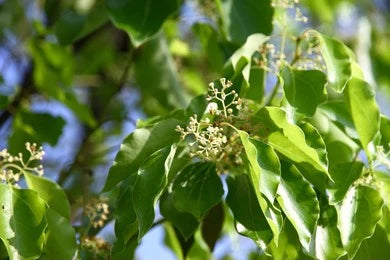Systemic Classification
Family - Lauraceae
Botanical Name - Cinnamomum camphora
Synonyms
Karpoor - It promotes health throughout the body by easing disorders
Ghansaar - Containing solid extract
Chandra - As it's cold and appears to be as white as the moon,
Himahva - It is cold and white as ice
Physical Appearance
- The evergreen tree of Kapoor is 100 feet long and 6 to 8 feet wide.
- Kapoor's bark is smooth on the inside but rough on the surface.
- This herb has 2-4 inch long leaves that have a yellowish-green tint, have a scent, and resemble tejpatras.
- The kapoor plant produces small, yellowish-white flowers that are grouped together in a bloom.
- The fruit of the kapoor tree is spherical like peas, dark green in hue, and grows in bunches. It turns black in October.
- Kapoor seeds have an aroma and are tiny in size.
- The season from February to March is when the old leaves drop off and the new leaves begin to emerge.
- The plant smells in all of its components.
Vernacular Names
Sanskrit Name - Karpura
Hindi Name – Karpur, karpuram
English Name - Camphor tree, Camphor laurel
Kannada Name – Pache karpoora
Bengali Name - Karpur
Telugu Name - Karpooram Chettu
Marathi Name - Karpur
Gujarati Name - Karpur
Tamil Name - Karpooram
Habitat
Kapoor is grown throughout the world in the nations of Taiwan, Japan, India, Sri Lanka, Madagascar, South Africa, and the United States. The first nation to make karpura is Taiwan, followed by Japan. It is cultivated in Kerala's western ghats in India.
Ayurvedic Properties
|
|
Hindi / Sanskrit |
English |
|
Rasa (Taste) |
Tikta, Katu, Madhura |
Bitter, Pungent, Sweet |
|
Guna (Physical Property) |
Ruksha, Laghu |
Dry, Light |
|
Virya (Potency) |
Sheeta |
Cold |
|
Vipaka (Post-Digestive Taste) |
Katu |
Pungent |
Effect On Doshas
It balances pitta dosha due to its cold power, soothes vata dosha due to its madhur (sweet) flavor and dispels kapha dosha due to its pungent qualities.
Chemical Composition
This plant has various active chemical constituents like thymol, Campherol, camphene, terpineol, borneol, linalool, and some other essential volatile oils.
Benefits
Kapoor has positive impacts on the body's many systems.
- It promotes the release of digestive juices, which enhances the condition of the digestive system.
- Rasayana (antioxidant) properties serve to slow the accumulation of free radicals and prevent degenerative changes in the body.
- Kapoor's remarkable analgesic and antispasmodic effects offer immediate relief from pain, cramps, and spasm.
- It has an anti-inflammatory (shotha hara) impact that aids in reducing muscular pain and pain brought on by inflammatory disorders like rheumatoid arthritis.
- This plant is also a very effective decongestant, easing breathing difficulties and clearing up congestion right away.
- It is regarded as a nervines tonic that improves general brain functions by stimulating the brain.
- The aphrodisiac (vajikarana) function of kapoor increases the reproductive hormones that are beneficial for enhancing reproductive health.
Home Remedies
- The stomach burning is lessened by mixing a pinch of kapoor with 20 cc of water.
- For many types of skin conditions, including dermatitis, itching, burning, and more, mix kapoor with coconut oil and apply it to the affected skin.
- Add Kapoor to lukewarm cow's ghee and put 2 drops inside each nostril for relief from epistaxis (nasal bleeding).
- Applying kapoor powder will help if you are experiencing tooth problems.
- It helps to reduce fever. Combine 1 pinch of Kapoor, 1 pinch of hing, a small amount of honey, and 2-3 drops of ginger; take this mixture twice a day.
- Burning kapoor makes your home clean and free of illnesses, making it a very effective disinfectant.
- Sesame oil can be added to Kapoor and used to massage the painful area. This will aid in pain relief.
Part Used
Niryas (extract)
Dosage
125-350 mg

